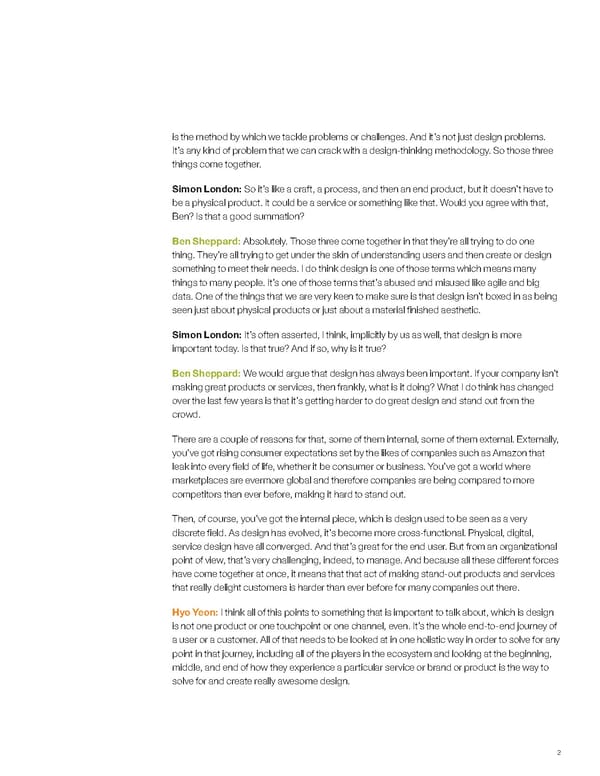is the method by which we tackle problems or challenges. And it’s not just design problems. It’s any kind of problem that we can crack with a design-thinking methodology. So those three things come together. Simon London: So it’s like a craft, a process, and then an end product, but it doesn’t have to be a physical product. It could be a service or something like that. Would you agree with that, Ben? Is that a good summation? Ben Sheppard: Absolutely. Those three come together in that they’re all trying to do one thing. They’re all trying to get under the skin of understanding users and then create or design something to meet their needs. I do think design is one of those terms which means many things to many people. It’s one of those terms that’s abused and misused like agile and big data. One of the things that we are very keen to make sure is that design isn’t boxed in as being seen just about physical products or just about a material finished aesthetic. Simon London: It’s often asserted, I think, implicitly by us as well, that design is more important today. Is that true? And if so, why is it true? Ben Sheppard: We would argue that design has always been important. If your company isn’t making great products or services, then frankly, what is it doing? What I do think has changed over the last few years is that it’s getting harder to do great design and stand out from the crowd. There are a couple of reasons for that, some of them internal, some of them external. Externally, you’ve got rising consumer expectations set by the likes of companies such as Amazon that leak into every field of life, whether it be consumer or business. You’ve got a world where marketplaces are evermore global and therefore companies are being compared to more competitors than ever before, making it hard to stand out. Then, of course, you’ve got the internal piece, which is design used to be seen as a very discrete field. As design has evolved, it’s become more cross-functional. Physical, digital, service design have all converged. And that’s great for the end user. But from an organizational point of view, that’s very challenging, indeed, to manage. And because all these different forces have come together at once, it means that that act of making stand-out products and services that really delight customers is harder than ever before for many companies out there. Hyo Yeon: I think all of this points to something that is important to talk about, which is design is not one product or one touchpoint or one channel, even. It’s the whole end-to-end journey of a user or a customer. All of that needs to be looked at in one holistic way in order to solve for any point in that journey, including all of the players in the ecosystem and looking at the beginning, middle, and end of how they experience a particular service or brand or product is the way to solve for and create really awesome design. 2
 Tapping into the business value of design Page 1 Page 3
Tapping into the business value of design Page 1 Page 3